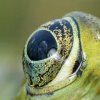Marsu42 said:
mackguyver said:
A flash will help and can definitely overcome the light, but why fight it?
Your feedback is very welcome!
As written above I don't see how I can manage to take these shots handheld in dimmer light: these frog don't just sit there like your infamous Florida models seem to do but swim and hop around most of the time so a tripod is out of the question - I could try a monopod though.
My 100L lens has IS, but with ~1/60s shutter speed and below the handheld keeper rate sinks to rock bottom. I need max. x-sync even on static subjects for reliable 100% crop sharpness (though of course this doesn't matter for the test upload size I chose). With thinner dof, wouldn't even get the eye in focus (see sample below with f7.1). Much higher iso in dimmer light or for deeper dof results in too much noise.
Btw these European "Teichfrösche" are not invasive, but are very friendly animals, just eat flies and some even like to be petted on the back

Marsu, it was late when I wrote you last night and I just had a chance to take a better look at your photos. I think they turned out well, particularly for your first time shooting them. The additional information is interesting and we have more than our share of invasive species in Florida as well! Also, that's funny that they like to be pet on the back! Here's what I think you did well:
- Your fill flash was balanced well
- You captured their personalities well in many of the shots
- You got the peak moment of their inflated cheeks in those shots
- The eyes are all in focus
- A couple of the portraits of single frogs came out really well with clean backgrounds
- You didn't submerge any of your gear

My suggestion to shoot in dimmer light is for many reasons. First of all, all wildlife is more active in the morning and as a result offers more interesting behavior like feeding and mating during the morning and evenings. Second, the flash is plenty bright to light the frogs if you get close enough (as your clearly are) and allows you to get better subject isolation (i.e. brighter subject, darker background). Without the sun competing, your flash actually has more power to illuminate. Also, you probably won't need the CPL if it's early enough, which will give you ~2 stops back. The key is getting the flash off axis enough to avoid the water and eye reflection (RE: family of angles). This last one applies to mid-day shooting as well. Use the CPL to filter the majority of the water reflection (leave some for realism or filter fully for dramatic effect) and then get the flash off camera at a distant angle to eliminate the reflections.
Here are some additional thoughts:
- Don't be afraid to crop - if you get further back, you can use a larger aperture while retaining the same DOF, plus you can get a lower effective angle without submerging.
- Keep the background as clean as possible or incorporate the background. Play with larger apertures and intentionally OOF areas.
- Consider moving the frog onto a branch or something. I don't touch the subjects I shoot, but I know many photographers do this with reptiles to get a clean shot. It's an ethical / personal thing, but you can always use the "invasive species" argument

- Also, don't be afraid of f/11, 16, and even 22. Yes diffraction does soften the image, but it's not the instant death that so many DSLR shooters fear. Of course you'll need more light, but all of photography is a trade off

-When shooting more than one subject (like your pet photos) try to line up their eyes or shoot them when they are far enough apart so the distant one can be blurred. Try to avoid blurring another frog in the foreground
Hopefully that will help a bit and while we have some slower frogs here in Florida, be glad that you don't have alligators or venomous water snakes!




